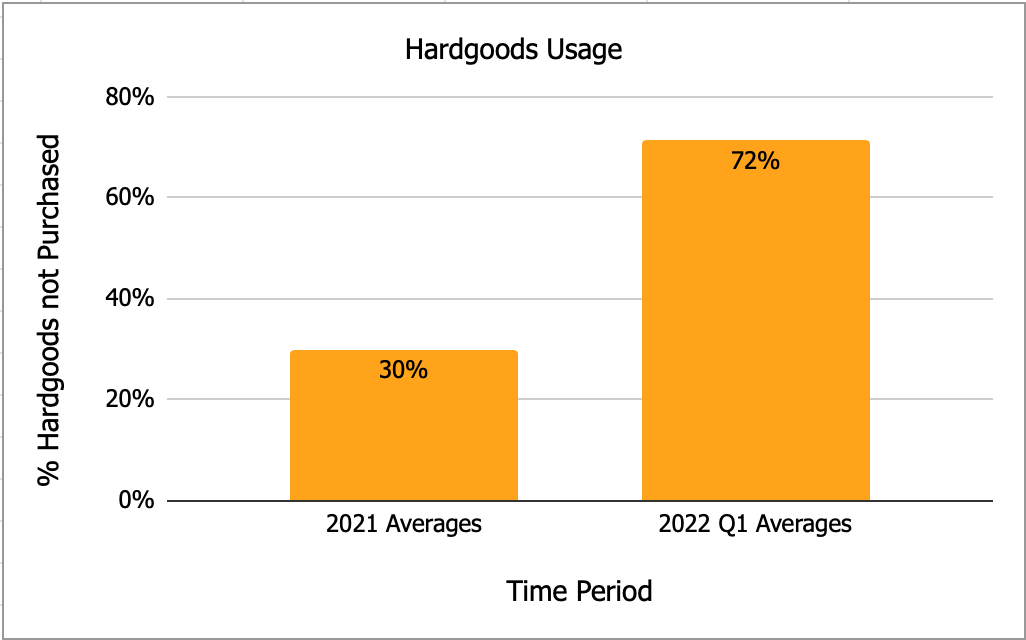SM IMPACT 2022 : QUARTER 1
Checking-in:
As the first quarter comes to a close, we are reminded that 'each journey begins with a single step'. Since sharing our 2021 Impact Report, we’ve enjoyed an outpouring of support and encouragement from the flower community. So many of you have decided to join us on our journey—or embark on your own–of re-envisioning floral design work as one that can be gentler on the Earth. Today, we're taking time to check in on how we’re pacing against 2022 emissions goals by diving headfirst into the first quarter’s worth of event data. Continually collecting, analyzing, and sharing our data keeps our team aligned – and we’re hoping this practice also bears an opportunity to learn with and learn from the growing community of small creative businesses foregrounding sustainability in their work.
Sustainability Goals
Use 50% or more of the hard goods in our inventory supplementing with rentals for our events by 2024.
Source 40% locally grown flowers across our events by 2024.
Compost a minimum of 50% of our floral waste across our destination events by 2024.
For California events, in accordance with state legislation, we will compost 100% of floral material from our events effective immediately.
By the Numbers
For this analysis, we’re looking at 2021 in aggregate and comparing those values with 2022 Q1, keeping the numbers relative for this reporting, rather than absolute. The first quarter of 2021 saw no event work as the world saw a spike in Covid-19 cases, and the event industry was hit with yet another round of postponements or event cancellations.
Sourcing: Local Flowers
Figure 1. Compared to 2021 in sum, this first quarter of 2022 saw a higher percentage of local flowers used per event. Per our first impact report, we define local flowers as ones that are grown in-state, wherever our event location may be. We were lucky to work with a few local flower vendors including Gather Flora, Floribunda farms, Posie Fields, and Velvet curation Co.. Our designs featured late winter and early spring blooms like flowering dogwood, coffee berry, muscari and tulips!
Sourcing: Hardgoods
Figure 2. Compared to 2021 in sum, we also reused or repurposed more of our hard goods inventory rather than purchase new vessels. As a team, we referenced our organized digital inventory to assess our options and sought out rental resources to supplement. For example, for an event in Napa, we rented a few vessels from our local flower friend, Sammy Lambert of Lambert Floral, reducing our consumption and supporting a more circular supply chain. In fact, en route to the event venue one of our team members picked up the rented vessels (we like to call it vessel carpooling).
Landfill Contributions
Compared to 2021 in sum, we’re making major strides in diverting waste material from landfill. In practice, we dedicate ample time to discover compost resources, assess our live & dried plant inventory, and search for plant-rental options. For all of our Q1 events, we were able to compost 95% of our eligible floral compost, saved product such as dried bamboo and lotus leaves for future designs, and planted live plants in our new Studio garden!
Additional Metrics
We’re also sharing the additional metrics of: miles traveled, waste generated, and carbon emissions generated from the first quarter of 2022.
Miles Traveled:
From January 1 - March 31, 2022 our team traveled 6,796 miles! This includes staff's commute to an event + all the required event transit, excluding the daunting and elusive number of miles imported flowers travel to an event. While the bulk of our business was conducted locally, this first quarter also found us on the east coast for an editorial, which contributed significantly to the number of miles traveled. Through travel by plane or car, our team generated 3.965 tons CO2 in Q1.
Composted Material:
From our event productions, we created 440 total lbs. of waste – 60 lbs. of which ended in landfill, and 380 lbs. diverted from landfill through composting or reusing materials. Using our growing compost-partner resource directory, we were able to compost at least a portion of all our events this past quarter.
Progress, Not Perfection
Looking at the data from last quarter in sum, it’s evident that we’re making slow and steady progress toward our sustainability goals– none of which would be possible without the support of:
Our Clients – We are fortunate to work with clients who champion sustainability, and are enthusiastic to see in-season, local botanicals in their designs.
Our Creative Partners – We benefit directly from our creative partners, including event planners, venue coordinators, and catering colleagues, who relay our mission and values to clients on our behalf.
Our Floral Vendors – The abundance and diversity of material we enjoy in our design work is directly tied to the work that our floral vendors do, whether they be farmers or wholesalers.
Our Freelance Team Members – We are thankful to our team of freelancers for living out our Studio values on event production and installation days.
Buoyed by the support of our community, we continue working with intention, one event at a time. With this new transparency is a newfound freedom that allows us to reimagine our work. The reminder for ourselves is that its progress, not perfection that we seek and celebrate.
Thanks flower friends!
All the best,
STUDIO MONDINE








